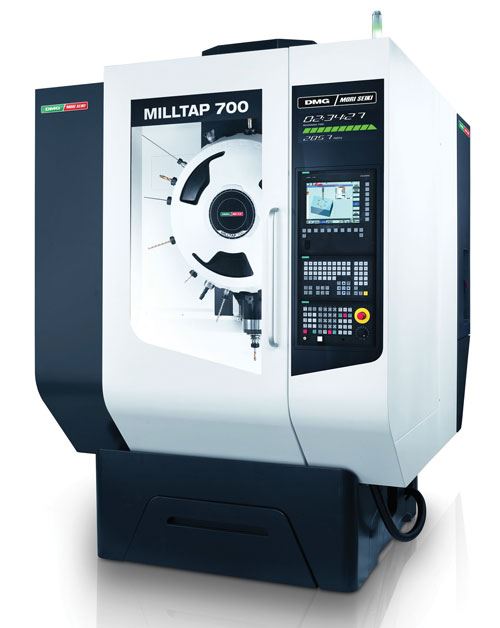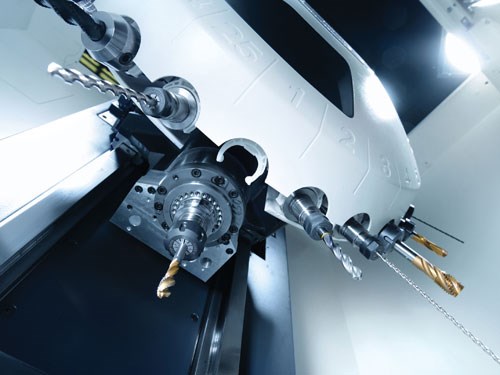By enhancing milling capability in a compact, high-speed vertical machining center,
DMG/Mori Seiki has redefined the role of the 30-taper machine in high-production applications. The company’s MillTap 700 features an unusually powerful spindle drive and high rapid traverse rates for a 30-taper production machine. Most 30-taper machines are designed for high speed drilling and tapping of aluminum or mild steel components in high volumes for the automotive and consumer electronics industries. Milling operations on these machines are often limited by low spindle torque and light-duty drives on the X and Y axes. However, advances in cutting tools, such as lightweight, balanced facemills, have enabled some milling to be incorporated for more complete processing of components.
The MillTap 700, in contrast, is designed to handle substantial milling duties in addition to the high-speed drilling and tapping of holes. For this reason, the company says, the machine’s C-frame configuration and triangular bed provide greater mass than typical designs, thus improving rigidity for facing and pocketing routines. Likewise, the high-torque spindle motor is rated at 33.3 hp (25 kW) to support these operations. Top spindle speed is 10,000 rpm (or 25,000 rpm, as an option).
In other aspects, this machine is clearly intended to fill the niche normally occupied by drill/tap machines for high-speed, high-volume production. For example, feed rates as high as 2,300 ipm (60 m/min.) and acceleration rates as high as 1.6 G characterize its dynamic performance. The 65 × 92-inch footprint is sized for the tight space allocations in production plants. Despite this compactness, the work area measures 27.6 inches (700 mm) in the X axis and 16.5 inches (420 mm) in the Y axis, with maximum Z-axis height of 15 inches (380 mm). Workpieces can be as heavy as 400 kg (880 lbs). Also notable is the fact that the worktable moves only in the X axis, whereas the spindle head moves in the Y and Z axes, thus eliminating the need for moving way covers required by cross-table designs. This improves chip flow and keeps the machine narrower at the front without restricting work capacity or accessibility.
Perhaps the most innovative feature of the machine is the toolchanger concept. The complete drive of the tool magazine is integrated into the spindle head. In operation, the rotary drum of the toolchanger tips in and out vertically to deliver tools to the spindle. This economy of motion achieves a chip-to-chip time of 1.5 seconds, the company says. The toolchanger holds 15 tools (a 25-tool design is optional).
The company is promoting the machine’s built-in energy management system, because production plants operating on a thin margin are becoming more sensitive to energy-related costs. The high-efficiency CNC unit and drive technology are said to reduce energy consumption by as much as 30 percent compared to machines from other builders.
Finally, this machine has the significance of being the first model designed as a joint effort of DMG and Mori Seiki engineers, who combined market research and customer input from both Germany and Japan. Production will be split between factories in Europe and Japan.





























